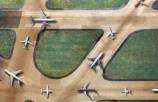Honeywell System To Enhance Safety Before Takeoff
When you're flying regular commercial service to some of the
most desolate regions in the United States... you must be on the
forefront of safety, says Alaska Airlines. Continuing the airline's
longtime practice of safety innovation, Alaska will be the first
major US passenger carrier to equip its entire aircraft fleet with
a system designed to help prevent accidents on runways and
taxiways.

The Runway Awareness and Advisory System (RAAS), developed by
Honeywell (NYSE:HON) in 2003, provides pilots with audible alerts
when they approach and enter taxiways and runways. The system
confirms runway identifications to help ensure pilots are on the
correct runway with enough distance to complete takeoff, and
provides an audible warning if a pilot inadvertently accelerates
for takeoff while on a taxiway.
Regulatory agencies, airlines and others in the aviation
community regard incidents in these operational areas -- known as
runway incursions -- as one of the industry's biggest safety
issues.
"Runways are a challenging environment where everything comes
together," said Gregg Saretsky, Alaska Airlines' executive vice
president of flight and marketing. "RAAS is the latest step in
Alaska's ongoing journey of innovation with Honeywell. By putting
this advanced situational awareness technology on all of our
planes, coupled with other systems we have in place, Alaska will be
flying the most technologically modern airline fleet in the United
States and our pilots will be assured of an additional layer of
safety while on the nation's runways."
Alaska Airlines began installing RAAS on its Boeing 737s in
July, after working with Honeywell to make sure the technology met
the carrier's specific operational needs. During the past three
years, Alaska pilots have helped develop and test RAAS. Alaska's
fleet will be fully equipped with the aural alert software by the
end of September.
 "The inclusion of RAAS throughout
Alaska Airlines' fleet reflects the safety leadership and strong
commitment from both Alaska Airlines and Honeywell to reduce runway
incursions," said Garrett Mikita, president of Honeywell's air
transport and regional business. "In today's increasingly crowded
airport environments, Honeywell's RAAS technology, customized for
Alaska to match their unique operating requirements, improves
safety by enhancing flight crew situational awareness."
"The inclusion of RAAS throughout
Alaska Airlines' fleet reflects the safety leadership and strong
commitment from both Alaska Airlines and Honeywell to reduce runway
incursions," said Garrett Mikita, president of Honeywell's air
transport and regional business. "In today's increasingly crowded
airport environments, Honeywell's RAAS technology, customized for
Alaska to match their unique operating requirements, improves
safety by enhancing flight crew situational awareness."
RAAS is a software enhancement to Honeywell's proven Enhanced
Ground Proximity Warning System (EGPWS), which warns pilots if they
fly too close to terrain. Alaska began installing EGPWS in its
aircraft in the mid-1990s and recently upgraded the system to
provide pilots with visual alerts for tall buildings and other
man-made structures.
Alaska Airlines' history of firsts includes other key systems
that provide pinpoint navigation and help pilots take off and land
in poor weather. In the mid-1990s, the airline pioneered Required
Navigation Performance (RNP), which uses the satellite-based Global
Positioning System to improve the carrier's safety and reliability
for flights operating in and out of Juneau, Alaska. Alaska Airlines
is the only US-based airline whose entire fleet is equipped to fly
RNP arrivals and departures, now authorized at 19 US airports.
The company's fleet also is equipped with the Head-Up Guidance
System. This technology provides aircraft performance and
navigation information in a transparent window positioned between
the captain and aircraft windshield, allowing takeoffs and landings
at the lowest minimum weather conditions certified by the Federal
Aviation Administration.
 Airbus Racer Helicopter Demonstrator First Flight Part of Clean Sky 2 Initiative
Airbus Racer Helicopter Demonstrator First Flight Part of Clean Sky 2 Initiative Diamond's Electric DA40 Finds Fans at Dübendorf
Diamond's Electric DA40 Finds Fans at Dübendorf ANN's Daily Aero-Term (04.23.24): Line Up And Wait (LUAW)
ANN's Daily Aero-Term (04.23.24): Line Up And Wait (LUAW) NTSB Final Report: Extra Flugzeugbau GMBH EA300/L
NTSB Final Report: Extra Flugzeugbau GMBH EA300/L Classic Aero-TV: 'Never Give Up' - Advice From Two of FedEx's Female Captains
Classic Aero-TV: 'Never Give Up' - Advice From Two of FedEx's Female Captains




